Seagull Survey (Part V)
The Ship’s Naturalist has been kept very busy over the past few weeks, caring for her two yellow-legged gulls. She has also been keeping her diary up to date, and the delay in bringing you part five of the Seagull Survey is through no fault of her own. Part six really will follow shortly – I promise!
This is the fifth article in a series of ten. If you haven’t already read the others, start with the first article!
For the full story of Roxanne’s hand-reared gulls and her study of the yellow-legged seagull colony on Isla Perdiguera, buy her book, Two Gulls and a Girl.
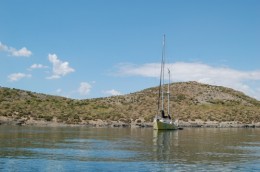 It is the middle of May and our six week old seagulls are no longer at all fluffy. They have feathers all over them now, and they have huge wings. To think that they were so tiny! And now that they have their beautiful wings they are desperately keen to fly.
It is the middle of May and our six week old seagulls are no longer at all fluffy. They have feathers all over them now, and they have huge wings. To think that they were so tiny! And now that they have their beautiful wings they are desperately keen to fly.
The first flight was made on the 12th of May – but it was not really a flight so much as a jump. Remus, the younger but bigger gull, hopped out of the box where he and his sister used to spend the night and flew down onto the floor. Next, on the 16th, the gulls both hopped up from the cockpit floor onto the seat. That was something they had never managed before, and they still couldn’t get from the cockpit seat up onto the deck.
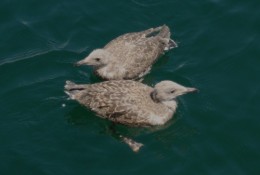 On the 12th of May we also took the birds swimming in the sea. Ever since they were small they have loved water. We first tried to wash their feet in it when they were rather filthy fluff balls, who had walked in their dinner. We thought that we would have to hold them into the water. After all, there is no water on Isla Perdiguera, and so none of the chicks there get much chance to paddle! But Romulus and Remus stayed in as long as we would let them, flapping, squeaking, splashing, and preening. After that we gave them a bath every day and it got to the stage where they would recognise their bath tub amongst the pile of buckets, and when I put it down near them on the cockpit seat they would run to it and leap in. Once I put it down with no water in it, and Romulus leapt in, squeaking and flapping and ducking, and trying to wash his beak. At last he stood up, cocked his head on one side (which is the only way that a seagull can look down or up) and cheeped at me, as if to say, “Where’s the water? Come on, you can’t fool me!”
On the 12th of May we also took the birds swimming in the sea. Ever since they were small they have loved water. We first tried to wash their feet in it when they were rather filthy fluff balls, who had walked in their dinner. We thought that we would have to hold them into the water. After all, there is no water on Isla Perdiguera, and so none of the chicks there get much chance to paddle! But Romulus and Remus stayed in as long as we would let them, flapping, squeaking, splashing, and preening. After that we gave them a bath every day and it got to the stage where they would recognise their bath tub amongst the pile of buckets, and when I put it down near them on the cockpit seat they would run to it and leap in. Once I put it down with no water in it, and Romulus leapt in, squeaking and flapping and ducking, and trying to wash his beak. At last he stood up, cocked his head on one side (which is the only way that a seagull can look down or up) and cheeped at me, as if to say, “Where’s the water? Come on, you can’t fool me!”
When I took them swimming Romulus and Remus behaved rather as I would have expected them to. They were a little scared, but as it was their first time on the big, deep sea it wasn’t surprising. They were used to being able to stand up in their bath. But they knew at once how to swim. The gulls on the island came rushing to see what was happening. They arrived within seconds! How did they know so quickly? How did they know that chicks were in the water? Did one bird who happened to be flying by raise the alarm? Within seconds the sky was speckled black with gulls. Romulus and Remus were afraid of the other gulls and stayed very close to Mollymawk. They spent a lot of time washing themselves and when we took them out again they were very soggy. They obviously didn’t have any oil on their feathers.
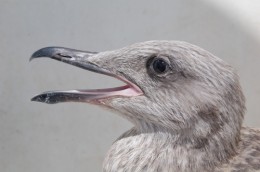 As Mummy mentioned when she shouldn’t have done, in Part III, we recently found out on the internet that male gulls are larger than females. (I jumped the gun… JDS) We decided that Romulus must be a girl – which was what we’d already guessed. But then I wrote to someone called Cristobal, who did a study of gulls at Vigo University, and he says that you can’t tell the difference until they are adults. Still, we do think that Romulus is a girl, because she’s so little and pretty and intelligent. Remus is big and he has a big square head, while Romulus has a rounded head, and Remus is greedy while Romulus is a delicate eater. We always think of her as a girl, so we have decided to change her name to Romulina.
As Mummy mentioned when she shouldn’t have done, in Part III, we recently found out on the internet that male gulls are larger than females. (I jumped the gun… JDS) We decided that Romulus must be a girl – which was what we’d already guessed. But then I wrote to someone called Cristobal, who did a study of gulls at Vigo University, and he says that you can’t tell the difference until they are adults. Still, we do think that Romulus is a girl, because she’s so little and pretty and intelligent. Remus is big and he has a big square head, while Romulus has a rounded head, and Remus is greedy while Romulus is a delicate eater. We always think of her as a girl, so we have decided to change her name to Romulina.
Remus is quite a pig. He wolfs down any kind of fresh fish or meat that I give them. They can’t manage tinned fish because it is too soft for them to pick up. One of their favourite foods is minced meat. We have to buy it specially for them, because we don’t eat any meat. They also like hake, which we buy frozen, and they like fresh fish, which is probably best for them. When I can’t catch any fish or we run out then I give them boiled eggs, and they crumble the yolks all over the place, pecking up the tiny bits after they have swallowed the whites. They like playing with crumbs of bread and little bits of vegetable. They like a varied diet. They get bored if I give them the same thing every day.
Once we got the birds four little cavalha (very small mackerel), two each. Remus grabbed the first fish and swallowed it whole. Then he snatched Romulina’s fish – but he couldn’t fit it in! He waddled about with the tail of the fish just out of his mouth, unable to swallow it because his stomach and even his throat were already full. He did look so silly! I had to cut up Romulina’s fish and hold them out to her.
On the 17th of May we watched a juvenile gull at Isla Perdiguera make what was probably his first flight. He was sitting on the water and he frantically flapped his wings, flew a very short distance just above the surface, and collapsed back into the sea. Later that same day we saw another big chick glide a few yards down the side of the island and into the sea. He was running away from us and perhaps it was his first flight. He swam a long way away, and when we looked again he was just a little brown dot sitting with a crowd of white dots – the adults. A while later we saw a juvenile flying with the adult gulls. It was flying very low over the water, and they were all yelling and some of them were mobbing it. Probably it was the same gull. Were the adults telling it to go higher? Was it a game, or was it aggression? We think the latter is most likely, because about a week later we saw a juvenile getting very badly mobbed so that it nearly fell out of the sky. However, Mummy likes to think that the adults were encouraging the juvenile and saying, “Well done!”
The following day, on the 18th, I took Romulina and Remus for another swim. This time I went in with them. The water was freezing! (To be precise, the water temperature was 21 degrees C / 71 F. And she was wearing a wetsuit. JDS) After the swim we picked up the birds, much to their disgust, and put them in the bottom of the dinghy. Romulina immediately hopped up onto the side of the dinghy, spread her wings and kicked off. Up into the air she went, about two feet up. She hovered for a split second wondering what to do, or how to get down, and then she flopped into the water. She had covered a distance of about four feet. This was her first ever flight. Mummy says it was like me taking my first steps! Remus stayed in the bottom of the boat, cheeping. He did not try to follow his sister.
On this same day we went ashore for our usual tour of the nests. We had been watching a nest which was in the seashore, right on the beach. In fact, it was actually built on top of the seaweed which had been thrown up during a storm. The storm was on the 19th of April, so we know the nest wasn’t there before that. It only had two eggs. We had been watching the nest, from the boat, the day before and the mother had been sitting there the whole time, from morning to night. She never left the nest while we were watching, and the male was standing close by for most of the time.
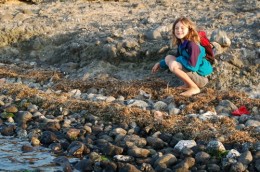 The first thing we noticed when we got up the next morning was that the gull was not sitting on her nest. That seemed very odd so we went ashore to look and we found that the eggs were not in the nest. One egg lay on the pebbles beside the nest, smashed open, and the other was gone. The chick inside the broken egg was dead. It looked to me as if it would have hatched in a week or so (but Mummy said she thought it looked as if it would hatch in just a couple of days.)
The first thing we noticed when we got up the next morning was that the gull was not sitting on her nest. That seemed very odd so we went ashore to look and we found that the eggs were not in the nest. One egg lay on the pebbles beside the nest, smashed open, and the other was gone. The chick inside the broken egg was dead. It looked to me as if it would have hatched in a week or so (but Mummy said she thought it looked as if it would hatch in just a couple of days.)
What happened? What did it? A human, perhaps, or an animal? Mummy’s suggestion, that a wave from a passing fishing boat may have gone over the nest, was quickly ruled out. A wave strong enough to lift out the eggs would have swept away the nest – and the nest was not even wet. That only left humans or animals, but what animal living on the island could have done it?
A snake? That is not very likely. A snake would probably not come down onto the beach, and anyway a snake couldn’t carry an egg away, especially not if it was being attacked by angry seagulls!
Another gull? That is even less likely, because a gull could not carry away an egg.
A rat? No, a rat would not be able to scare away the gulls. They would kill it easily.
What other predators are there on the island? We do not know of any, but there are signs. Every now and then I find a dead bird or a dead rabbit which has been torn apart. A snake obviously couldn’t tear up a bird. A rat couldn’t either. Rats can chew but these birds have had their wings or their heads torn off. Another gull couldn’t do that, and besides I am strongly under the impression that gulls leave their dead alone, except perhaps for the long dead ones, which are only bones and feathers. Then they take some of the breast feathers to line their nests. (“Well, Darling,” one says to the other, “She’s dead now anyway, so we might as well make use of her feathers. I’m sure she wouldn’t mind, poor old thing.”)
Not many of the dead gulls are torn apart at this time of the year, and I think that this could be because the animal has found better things to eat, such as chicks – and eggs.
(Hmmm… Before you all run away with the idea that there is an escaped leopard lurking in the tunnel on Perdiguera, slinking out at nights to tear up corpses, I should like to point out that this island is occasionally visited by people with dogs. This doesn’t solve the Mystery of the Eggs, but I think it probably explains the dismembered birds. JDS)
So that just leaves people. But what sort of person would have done this? After we saw that the eggs had been taken and destroyed Mummy remembered that she had heard the gulls all screaming loudly very early in the morning, just after dawn. Who would be up at that time of day? In the Mar Menor only a fisherman would be up so early, and they very rarely go ashore. Anyway, why would a fisherman want to smash the eggs? I don’t understand why, but it seems that some people get pleasure from killing feeble helpless animals. Once we found a chick – a fluffy little two day old thing, so cute and lovely – which had been hung up in a tree between two branches. Only a human could do that. Maybe they’re the same people who paint rude graffiti on other people’s buildings.
Once while we were sailing into the anchorage we saw a family of six – mother, father and four children, the youngest aged about ten – who were climbing about on the hillside, banging the bushes with sticks and throwing stones up into the air at the gulls who were dive bombing them. They eventually found a chick and took it back to their boat. Then the boys and the man went back to look for a second chick, and they eventually found a rather bigger one. Of course, I can hardly object to other people taking away chicks, but it didn’t look as if these were the sort of people who would take good care of a baby seagull. Looking after a baby seagull is hard work and when Romulina and Remus were small most of my day was filled with feeding and cleaning. Would these people manage to get the baby birds to eat? Do they know how to feed them using a syringe? Would they be willing to spend lots of money on fresh fish? And would somebody who throws stones at adult birds be kind to a scruffy fledgling? Even if these chicks survive I think they will end up being cage birds. The people who took them probably live in an apartment block, like most people in Spain. How would they ever let the birds go flying? Unless you live right beside the sea you cannot really let a young gull go flying. It would be dangerous to let one loose in a town. Really, if you want to bring up a baby seagull, you need to live right beside a seagull colony.
I suppose that the sort of person who hangs baby chicks or throws stones at adult gulls is the sort of person who would also smash eggs. It is a mystery that we shall never solve – until we find an egg-eating snake or a panther that lives in the tunnel! (The tunnel on Isla Perdiguera is no ordinary affair, and there are not many people who won’t admit to finding it a little bit spooky. There are several black vaults along its length, and anything could be hiding in there, watching us go past… It’s called Basilisk Tunnel on Roxanne’s map, because Caesar once saw a big black snake go slithering into a crack in the wall.)
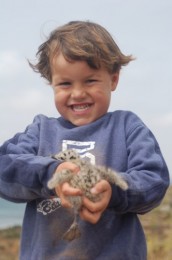 The day after we saw the people take away the two chicks a friend of ours came to visit the island with his girlfriend and two children. The children are boys aged eight and four, and they are a bit wild. When they saw that we were looking at the nests they wanted to join us, but at first we tried to keep them away. We were afraid that they would step on the chicks or scare them into running away from their nests. Then we thought about it some more, and we decided that we did not want Gonzalo and Jorge to grow up to be people who hang chicks or throw stones at birds. So in the afternoon we took them with us and showed them some nests with eggs and some little chicks. We even managed to show them a nest with a chick hatching. And we explained that you mustn’t keep the adult birds away from the nests or the babies will die.
The day after we saw the people take away the two chicks a friend of ours came to visit the island with his girlfriend and two children. The children are boys aged eight and four, and they are a bit wild. When they saw that we were looking at the nests they wanted to join us, but at first we tried to keep them away. We were afraid that they would step on the chicks or scare them into running away from their nests. Then we thought about it some more, and we decided that we did not want Gonzalo and Jorge to grow up to be people who hang chicks or throw stones at birds. So in the afternoon we took them with us and showed them some nests with eggs and some little chicks. We even managed to show them a nest with a chick hatching. And we explained that you mustn’t keep the adult birds away from the nests or the babies will die.
It worked very well, and now the older boy can’t wait to visit the island again. I gave him an empty eggshell and he took it to school to show to his class.
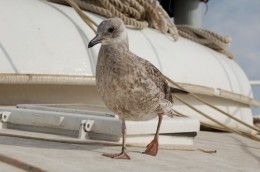 When they were tiny Romulina and Remus lived in a big plastic crate, and when they outgrew the crate we let them live in the cockpit and at night we brought them in and put them in a big plastic box. As they got bigger still their box became very cramped and we decided they were strong enough to sleep outside on the side deck, behind a wind break. For the first two nights they were a bit frightened and kept calling me to come and get them in! The deck was a good place for the birds while they couldn’t fly, but when they reached the half way stage and could nearly fly it was not so good. They might have flapped their wings so much that they went up into the air, got carried off by the wind, and not been able to get back aboard. So we saw that until they could fly perfectly we would have to put a net over the top of the side deck. When we were on deck they could come out and wander around on the whole deck, but if we were not there they had to go back on the port side deck with the net over them.
When they were tiny Romulina and Remus lived in a big plastic crate, and when they outgrew the crate we let them live in the cockpit and at night we brought them in and put them in a big plastic box. As they got bigger still their box became very cramped and we decided they were strong enough to sleep outside on the side deck, behind a wind break. For the first two nights they were a bit frightened and kept calling me to come and get them in! The deck was a good place for the birds while they couldn’t fly, but when they reached the half way stage and could nearly fly it was not so good. They might have flapped their wings so much that they went up into the air, got carried off by the wind, and not been able to get back aboard. So we saw that until they could fly perfectly we would have to put a net over the top of the side deck. When we were on deck they could come out and wander around on the whole deck, but if we were not there they had to go back on the port side deck with the net over them.
We were not at Isla Perdiguera when Romulina flew her first proper flight. We were at the other end of the Mar Menor, at La Ribera. Perdiguera is not very far away as the seagull flies, and it is still in sight. Sub-adult gulls who do not have to worry about nest building come and hang around here. It is right beside the airport, with military jets and planes flying in and out, so it was a very appropriate place to learn to fly! It was the 21st of May and when we lifted the net off the side-deck the birds hopped up onto the coach roof and both started to flap their wings. This was quite usual, but this time Romulina looked up at the sky. She had often seen adult gulls flying above the boat and from the time when she was just a few days old she had watched them. Now she wanted to be up in the sky too.
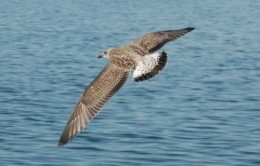 Remus was less keen. He has never paid much attention to other birds flying around the boat. He somehow knew that if he flapped enough he would fly, and he sort of wanted to, but at the same time he was scared. He flapped his wings and went up – but then he fell straight down again onto the deck because he had stopped flapping! Then he began to flap quite desperately – but he made sure that he was hanging onto a rope with his beak! Romulina flapped and flapped. Then all of a sudden she leapt bravely into the air. She caught her wing on the halyard which holds up the anchor ball, and I thought that she would fall, but she didn’t stop flapping. There was just a brief struggle to be free of the halyard and then she was up and flying in a big circle round the boat!
Remus was less keen. He has never paid much attention to other birds flying around the boat. He somehow knew that if he flapped enough he would fly, and he sort of wanted to, but at the same time he was scared. He flapped his wings and went up – but then he fell straight down again onto the deck because he had stopped flapping! Then he began to flap quite desperately – but he made sure that he was hanging onto a rope with his beak! Romulina flapped and flapped. Then all of a sudden she leapt bravely into the air. She caught her wing on the halyard which holds up the anchor ball, and I thought that she would fall, but she didn’t stop flapping. There was just a brief struggle to be free of the halyard and then she was up and flying in a big circle round the boat!
“Hooray for Romulina!” cried Mummy.
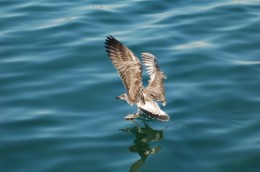 Immediately all the local sub-adult gulls turned up, and our baby started to get nervous. After just one lap she started to get worried about how she would land again (and if you’ve ever flown a First Solo, for a PPL, you will know how she was feeling! JDS) She made as if to land on the boat but didn’t know how. After two laps she landed in the water. This was a good idea, but she didn’t even really know how to do that. She did not fold her wings in quickly enough and so there was a big splash. She had flown both her circuits at about six feet off the water. I went to fetch her with the dinghy.
Immediately all the local sub-adult gulls turned up, and our baby started to get nervous. After just one lap she started to get worried about how she would land again (and if you’ve ever flown a First Solo, for a PPL, you will know how she was feeling! JDS) She made as if to land on the boat but didn’t know how. After two laps she landed in the water. This was a good idea, but she didn’t even really know how to do that. She did not fold her wings in quickly enough and so there was a big splash. She had flown both her circuits at about six feet off the water. I went to fetch her with the dinghy.
Remus, although he was quick when learning to eat, was rather slow at learning to fly. On the next day Romulina improved her flying technique and went about ten times round the boat, in a low circle. After several attempts she managed to land aboard the boat. It was very difficult for her to find a way of landing without crashing into the rigging. The juveniles on the island don’t have this trouble. And anyway, they usually swim back to shore. Remus was still too scared to fly. He ran up and down the deck flapping, but he kept grabbing hold of a mooring rope while he flapped. (He was like a child who is scared to jump into the swimming pool. JDS) However, on the next day, after a lot of running up and down flapping, he finally flapped up into the air and flew one and a half times round the boat before landing on the water. Romulina was very pleased! She flew along with him and then, after he had landed, she kept trying to get him up again by gently dive bombing his head. “Come on, Remus! It’s such fun!”
He did try. He flapped his wings and walked along on the water. It was ever so funny! I had to fetch him in the dinghy, but the next day when the same thing happened he saw the dinghy coming and flew back onto the boat.
The birds were both just over seven weeks old when they flew. To be exact, they were both 51 days old.
For the full story of Roxanne’s hand-reared gulls and her study of the yellow-legged seagull colony on Isla Perdiguera, buy her book, Two Gulls and a Girl.

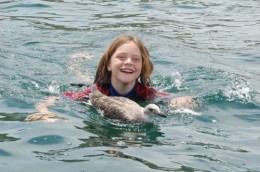
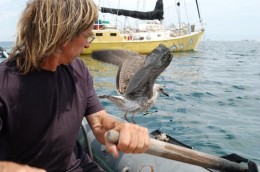
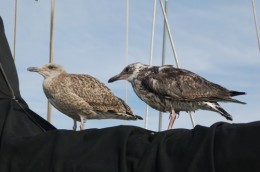
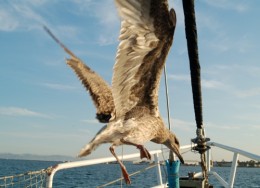
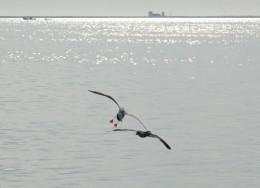
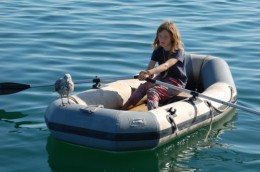
Greetings Roxanne and All,
Many thanx for that lovely account. I’m sure you’ll cherish your swims with them for the rest of your life! Beautiful pic. of Romulina circling!
Regs.,
Hello Crew, I wonder if there are any Mustelids on the island? Possibly something got away with one egg and while the adults were trying to fight it off, the other got smashed.
Romulina Rules O.K!
We hadn’t thought of that – perhaps that’s why there are so many dead rabbits on the island. But do you think that an animal of that size would be able to carry off an egg the size of a chicken’s egg? We haven’t seen any droppings, but droppings might easily be lost in the stones on the island.
Roxanne
Hi Roxanne and Jill,
I’ve just read accounts IV and V – fascinating stuff.
First of all, I think you’re very brave, returning to the island after being dive-bombed.
Your observations about the bullying are interesting. I’ve seen how adults will harry young gulls mercilessly, and at first thought it was pure aggression. Then it occurred to me it might be a kind of “tough love”, a way of forcing the gulls to “espabilarse” – by putting them through a type of initiation ordeal.
Regards,
Lucy
Mummy loves being dive-bombed – she spends her whole time taking photos of them inches above her head – but she has only been hit a couple of times, and I, after being hit several times, have taken to wearing a hat!
Hi to All,
thank you for your ongoing project Roxanne. I think that you did the best thing in showing the two young lads how the chicks develop. A little understanding now may spark greater interest for the wildlife that they encounter later.
Excellent teamwork of course…as the diary, photo story and layout all work well together!